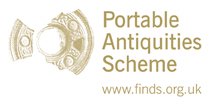Server check!
You are on the training database
Pins
Pins were used primarily for dress fastening and adornment, as far as can be gathered from the evidence, and feature heavily in the later Bronze Age (c.1,150-800 BC). They had their beginnings some 300 years earlier with simpler types appearing on both the Continent and in Britain, with several distinct types appearing: both foreign imports and local inventions. It has been pointed out that the decoration of these pins and the size of some of the pin heads indicates they were items of decoration and not intended to be discreet.
MBA pins (c.1,500-1,150 BC)
Disc-headed pins: These pins have a homogeneous, widespread British presence, with the main morphological difference being the variation of the shaft: either looped or perforated. They had flat disc-shaped heads, with a boss on the top, which are usually conical. The heads can differ slightly, with examples with "sunflower" heads appearing, as well as decorated and undecorated bosses featuring on the disc-head. Finally, examples are known with bent and straight shafts, as noted by Eogan (1974).
Picardy pins: Picardy type pins can be identified by the swelling of the neck and they are usually decorated with incised linear decoration. The decoration is quite varied showing individuality and they can be perforated or looped.
Pins related to Picardy pins: These pins are noted by O'Connor (1980: 76) as being probably derivatives of the Picardy pin type, linked by the single looped example from northern France. The variants can include thinner disc heads, loops, double-swellings, and incised ornaments.
Quoit-headed pins: Rowlands (1976: 86) notes that this pin type is "peculiarly insular" and has no continental relationships. It is comprised of a simple bronze loop attached to a long slender shaft that is either rounded or square in section. There is much variation within this type in both style and function, but it was noted that these pins probably represented the first indigenous use and manufacture of bronze pins in this country, and is echoed later on in the LBA pin types.
LBA (Penard metalwork phase pins: c.1,300-1,140 BC)
Poppy-head pins: These pins, whilst almost exclusively continental, have been shown to have spawned derivatives, with one such example appearing in Homington, Wiltshire. They commonly feature moulded ornamentation on the head, whilst the derivatives are identified by their general form and ribs on the shaft. The Homington pin is noted by Rowlands as being a "rather remote derivative"
Pins with trumpet heads and ribbed swollen shafts: Pins belonging to this type are generally found in north-eastern France and adjacent areas, with several examples appearing in the South-East of England. Some of these from the continent feature loops, linking them with Picardy pins and other MBA ribbed examples.
Pins from Gwithian, Cornwall: The settlement site at Gwithian produced fragments of two pins of distinctly unique type and form, certainly in Britain. The first was a small bronze pin with a ribbed pyramid head, with a notched decoration on the head and the shaft was noted as once having "an incised herringbone decoration", but which was lost during conservation (Rowlands 1976: 203). The other had a biconical ribbed head of globular shape, and a round sectioned shaft which is noted to change to a lozenge section below the decoration. The head is decorated with opposing diagonal lines or notches (noted as "herringbone" by Rowlands) which runs down on to the upper part of the shaft before ending in a panel of cross-hatching.
Shepherd's crook pins: Only one of these pins has been found in Britain (Dinorben, Denbigh, North Wales) and has been noted by O'Connor (1980: 124) as being of presumably French origin. These were claimed by Childe (1930: 106) to represent the natural progression from looped pins, and that this type became very common in East-Central Europe. They literally were of the form of a shepherd's crook, resembling a near complete loop with the gap lending these pins their name.
Pins with broad ribbed biconical heads: These pins are quite rare in Europe and only one has been found in Britain, a single find in Cambridge. This find, is comparable to finds from the middle and upper Rhine, as well as finds from Anjou, suggesting a possible Continental origin for this pin.
Pins with flat biconical heads: These have flat or truncated heads with a biconical profile, and are especially common in northern Italy. Alternatively, they may feature ribbed, as opposed to incised ornament on the head, particularly found in Bavaria. Two pins from the Thames were found with a notched rib around the head, linking them with this group, but also a small group of pins from Hesse, a state just east of the Rhineland.
LBA (Ewart Park metalwork phase pins: c.1,020-800 BC)
Roll-headed pins: These pins were very prevalent in the MBA in Europe, but only appear in Britain in the LBA, and are quite widespread, reaching as far Durham, but mainly concentrated in the South East.
Nail-headed pins: These pins are a heterogeneous group, with heads that are approximately circular, flat or slightly convex, and usually with a slightly conical lower profile. The diameter of the head may be up to four times the diameter of the shaft; and thus it is not always easy to separate large nail-headed pins and small disc-headed pins.
Vase-headed pins: pins with large ribbed vase-shaped heads appear across Europe and are heavily associated with late Urnfield contexts. Normally, these pins don't appear in hoards, but one exception is the Fenny Bentley pin which was found with a hollow-bladed spearhead.
Cup-headed pins: These pins are characteristic of Ireland, but are found in England as well, with a noted find at the Heathery Burn Cave. They are quite similar in appearance to disc-headed pins, and are found in similar locations.
Wart-headed pins: This pin is a Nordic Late Bronze Age Type, but one has been found in Britain in the same area as others types and may have straight or curved shafts. The example from Sion Reach (Middlesex) has a straight shaft, so is presumably of north German origin, Rowlands even pins the location to the Elbe estuary (Hamburg). Thus, it is a rare example of a Nordic export in Southern Britain.
Convex-headed pins: This typology encompasses various miscellaneous forms of pins with convex heads of varying shape. Three such pins have been thus far in Britain: Ivinghoe Beacon (Bucks), Fenny Bentley hoard (Derbys) and Tan Hill (Wiltshire).
Pins with small globular heads and ribs: Only one pin has been found in Britain conforming to this type, and was found in the Minnis Bay hoard. Otherwise they appear in North-Eastern France, leading to the conclusion that the Minnis Bay find is probably an import.
References
- Eogan, G, (1974). Late Bronze Age Pins Ireland: Journal of The Royal Society of Antiquaries of Ireland Volume 104, pp98-107
- Lawson, A. (1976). Bronze Age Hoards: Some finds old and new. In BAR British Series 67. Appendix 2 76-77
- O'Connor, B. (1980) Cross Channel Relations in the Later Bronze Age. Oxford: British Archaeological Reports S91
- Rowlands, M.J. 1976 'The Production and Distribution of Metalwork in the Middle Bronze Age in Southern Britain: Part ii'. Oxford: British Archaeological Reports.


